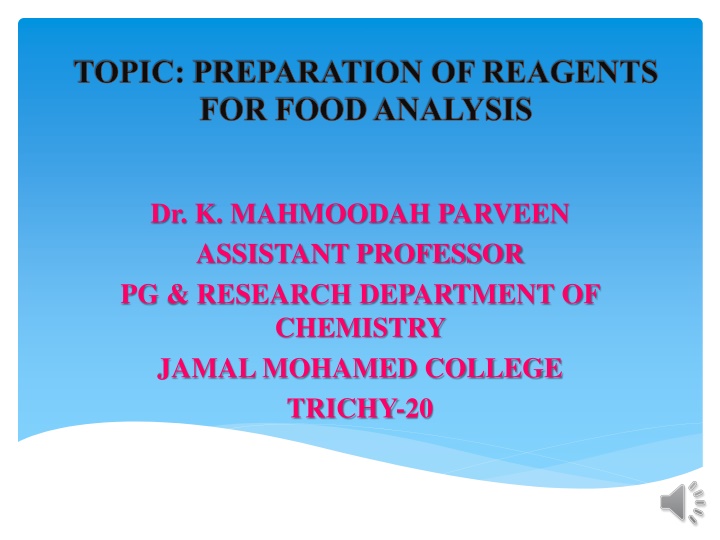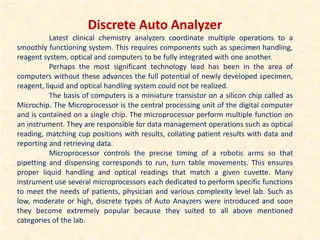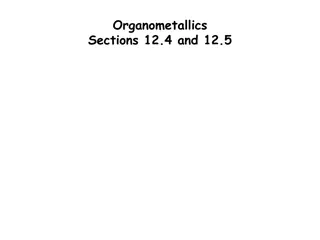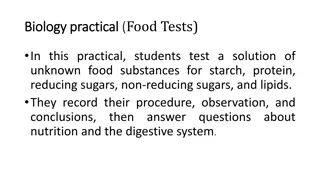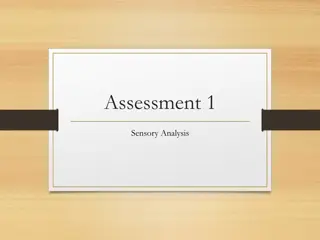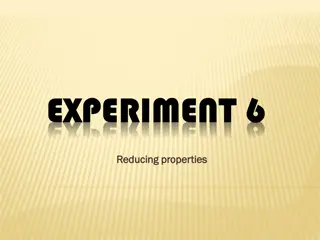Reagent Preparation for Food Analysis: Barfoed's and Seliwanoff's Tests
Preparation of reagents such as Barfoed's reagent and Seliwanoff's reagent is essential for detecting monosaccharides in food analysis. Barfoed's test utilizes a mixture of acetic acid and copper(II) acetate to detect reducing sugars, while Seliwanoff's reagent helps identify ketoses in solutions. Understanding the principles and procedures involved in these tests is crucial for accurate food analysis.
Download Presentation

Please find below an Image/Link to download the presentation.
The content on the website is provided AS IS for your information and personal use only. It may not be sold, licensed, or shared on other websites without obtaining consent from the author.If you encounter any issues during the download, it is possible that the publisher has removed the file from their server.
You are allowed to download the files provided on this website for personal or commercial use, subject to the condition that they are used lawfully. All files are the property of their respective owners.
The content on the website is provided AS IS for your information and personal use only. It may not be sold, licensed, or shared on other websites without obtaining consent from the author.
E N D
Presentation Transcript
TOPIC: PREPARATION OF REAGENTS FOR FOOD ANALYSIS Dr. K. MAHMOODAH PARVEEN ASSISTANT PROFESSOR PG & RESEARCH DEPARTMENT OF CHEMISTRY JAMAL MOHAMED COLLEGE TRICHY-20
BARFOED REAGENT Barfoed's test is used to detect the presence of monosaccharide (reducing) sugars in solution. Barfoed's reagent, a mixture of ethanoic (acetic) acid and copper(II) acetate, is combined with the test solution and boiled. A red copper(II) oxide precipitate is formed will indicates the presence of reducing sugar.
PREPARATION OF BARFOED REAGENT Barfoed's reagent: Dissolve 13.3 g of copper acetate in 200 ml of distilled water and add 1.8 ml of glacial acetic acid to it. Method/Procedure: Take 1ml of test sample/solution in the tube. Add 2ml Barfoed's solution.
PRINCIPLE INVOLVED IN BARFOEDS REAGENT Principle: Barfoed's test reaction is based on the reduction of cupric acetate by reducing monosaccharides and reducing disaccharides. Reduction of cupric acetate produces cuprous oxide which gives a brick red precipitate. Monosaccharides usually react in about 1-5 min and produce a red precipitate.
USES OF BARFOEDS TEST Barfoed's test. Barfoed's test is a chemical test used for detecting the presence of monosaccharides. It is based on the reduction of copper(II) acetate to copper(I) oxide (Cu2O), which forms a brick-red precipitate. (Disaccharides may also react, but the reaction is much slower.)
PREPARATION SELIWANOFFS REAGENT Preparation of Seliwanoff's Reagent: Dissolve 110 mg of Resorcinol in 220 ml of 3N HCl. The reagent is stable at RT. 8. Preparation of Molisch's Reagent: Dissolve 3.75 g of 1-naphthol in 25 ml of Ethanol 99%.
USES OF SELIWANOFFS REAGENTS Seliwanoff's test is used to distinguish aldoses from ketoses. On treating with conc. Acid, ketoses are dehydrated more rapidly to give furfural derivatives and on condensation with resorcinol give cherry red complex. The test will be answered by fructose, sucrose and other keto containing carbohydrates.
BIALS REAGENT Bial's reagent consists of 0.4 g orcinol, 200 ml of concentrated hydrochloric acid and 0.5 ml of a 10% solution of ferric chloride. Bial's test is used to distinguish pentoses from hexoses; this distinction is based on the color that develops in the presence of orcinol and iron (III) chloride.
Preparation and Uses Bial's reagent consists of 0.4 g orcinol, 200 ml of concentrated hydrochloric acid and 0.5 ml of a 10% solution of ferric chloride. Bial's test is used to distinguish pentoses from hexoses; this distinction is based on the color that develops in the presence of orcinol and iron (III) chloride.
